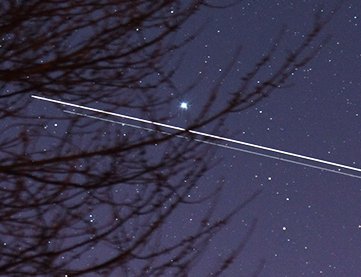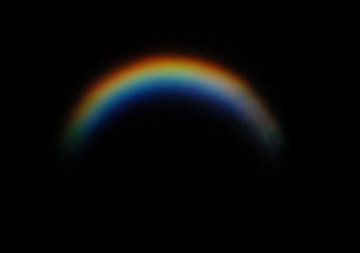| ASTEROID FLYBY: Newly-discovered asteroid 2009 FH is flying past Earth today, March 18th, only 85,000 km (0.00057 AU) away. That's a little more than twice the altitude of a geosynchronous communications satellite. There is no danger of a collision with the 20-meter-wide space rock--just a close shave. Experienced amateur astronomers can track 2009 FH using this ephemeris. It is shining about as brightly as a 14th magnitude star. asteroid images: from Eric Allen of Observatoire du Cégep de Trois-Rivières, Champlain, Quebec, Canada; from Dean Drumheller of San Mateo, California; SPACESHIP SIGHTINGS: Space shuttle Discovery docked to the International Space Station on March 17th at 5:20 p.m. EDT. Just before the two spaceships joined, Quintus Oostendorp watched them fly side-by-side over his backyard in the Netherlands: 
"It was a beautiful sight seeing both spacecraft moving together past the bright star Sirius," says Oostendorp. "I photographed the event using my Canon 350D." Now that Discovery is docked, construction can begin. The shuttle is delivering a new set of solar arrays to the station. They will be bolted in place on March 19th and unfurled on March 22nd. The arrays are so large, you can actually see them through backyard telescopes. The trick is knowing when to look. more images: from Jens Hackmann of Weikersheim, southern Germany; from Marco Langbroek of Leiden, the Netherlands; from Matthew Cook of Ann Arbor, Michigan; from Robert Hoetink of Enschede, the Netherlands; from Dennis Put of Brielle, Zuid-Holland, the Netherlands; from Guy Blattmann of Saint-Etienne-de-Crossey, France RAINBOW PLANET: Something special is happening to Venus. The brightest of all planets is hanging low in the western sky at sunset, and if you look at it with a backyard telescope, you'll see that it is a slender 4% crescent. But that's not the special part. What's special is, Venus looks like a rainbow: 
Mark D. Marquette took the picture from Boones Creek, Tennessee on March 16th. It shows the view through his 8-inch Celestron. "There was an extreme rainbow effect," he says. Venus resembles a rainbow because Earth's atmosphere acts like a prism. When Venus is near the horizon, refraction separates the red crescent from the blue. The crescent is so thin, the splitting of colors is obvious. Later this month, Venus will disappear into the glare of the spring sun--so catch the rainbow planet while you can! more images: from Maurice Gavin of Worcester Park SW London UK; from Sadegh Ghomizadeh of Tehran, Iran; from Joe Ricci of Rochester, New York; from Elias Chasiotis of Markopoulo, Greece; from Lorenzo Comolli of Tradate (VA), Italy; from Paul Kinzer of Galesville, Wisconsin; from P-M Hedén of Vallentuna, Sweden; from Alan Simpson of Renfrew, Scotland; from Frederic Caron of Victoriaville, Qc, Canada; from Paul Schneider of Wilton, Connecticut;
March 2009 Aurora Gallery
[previous Marches: 2008, 2007, 2006, 2005, 2004, 2003, 2002]
Comet Lulin Photo Gallery
[Comet Hunter Telescope: review] [Comet Lulin finder chart]
Explore the Sunspot Cycle | 
